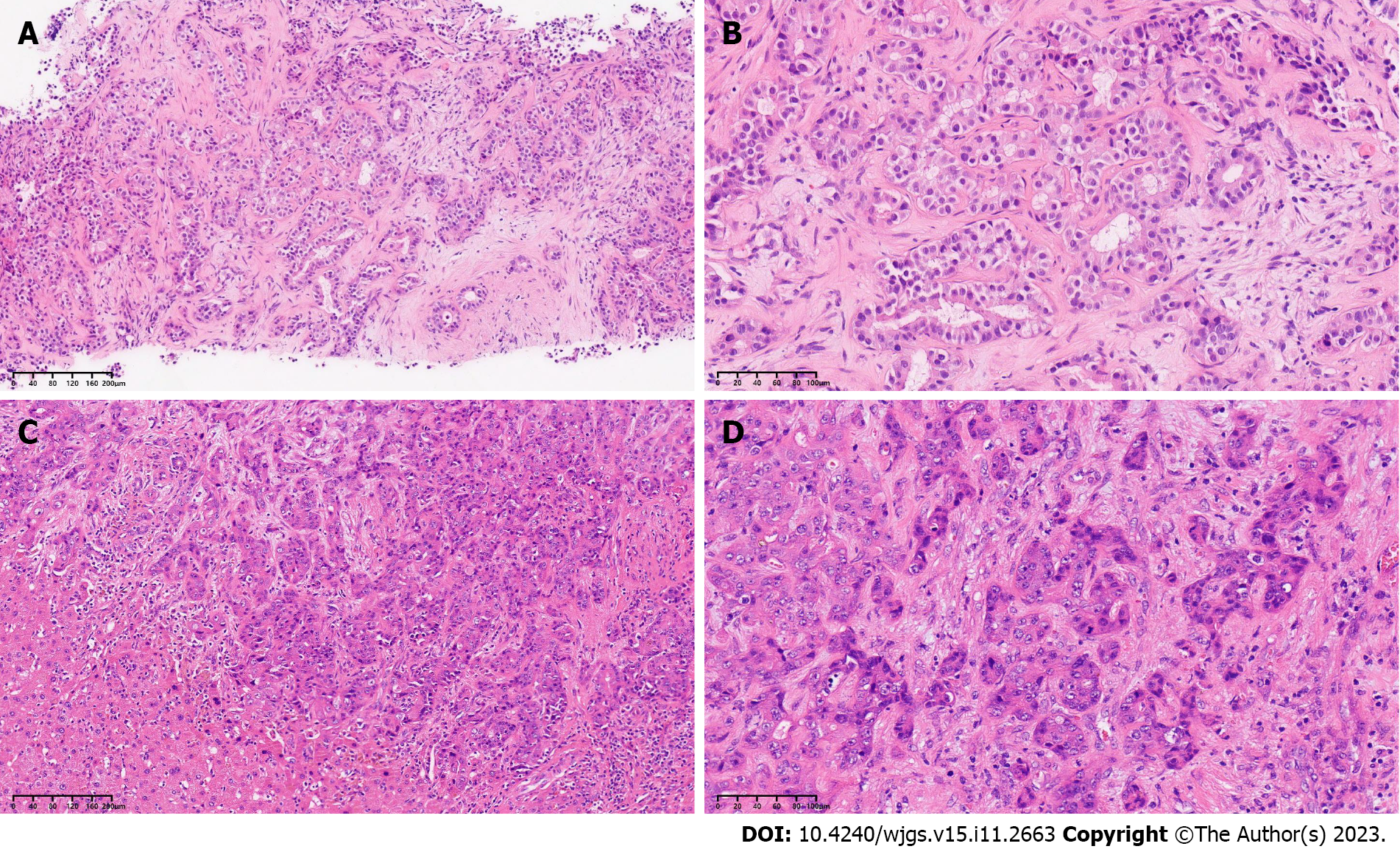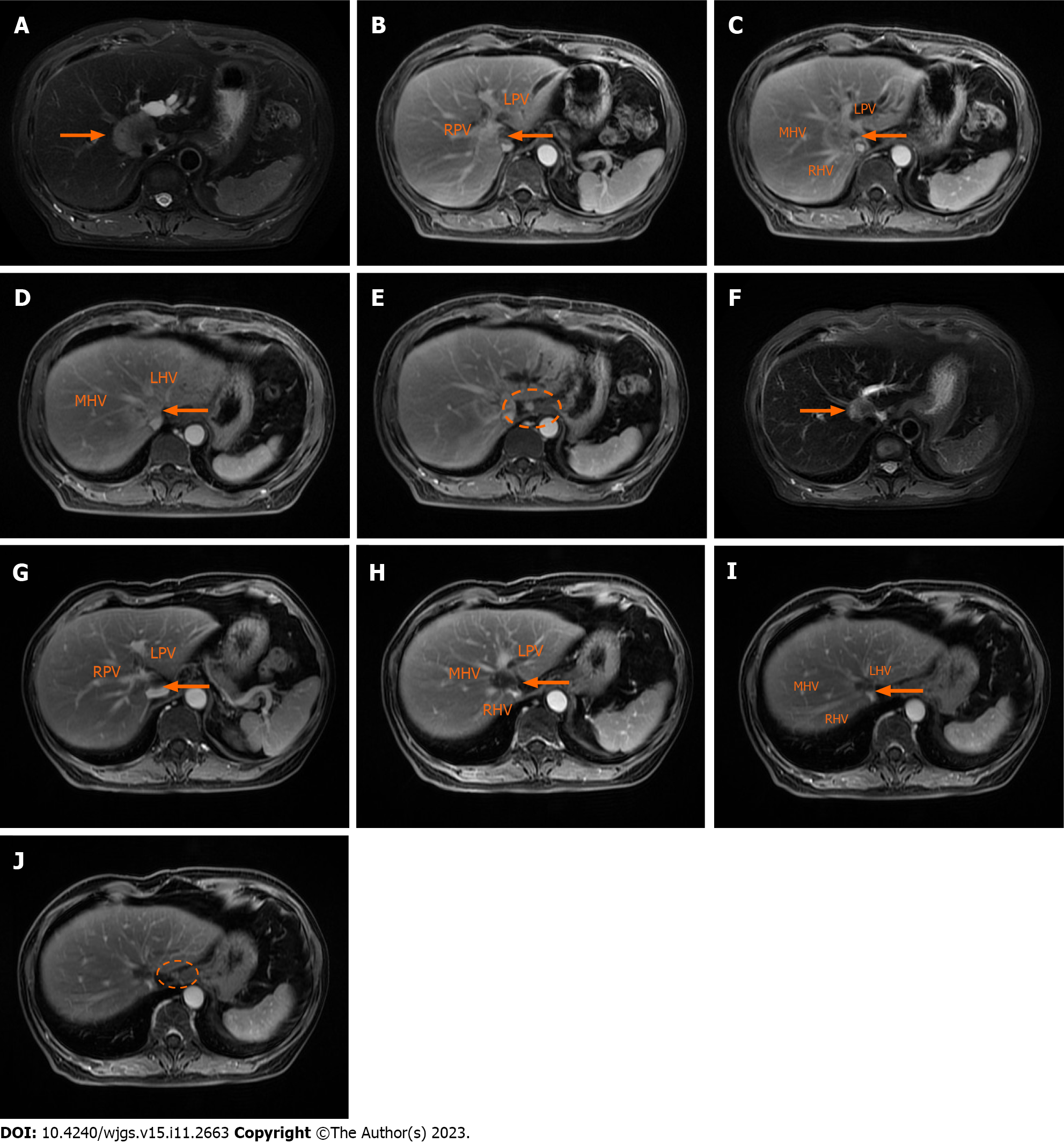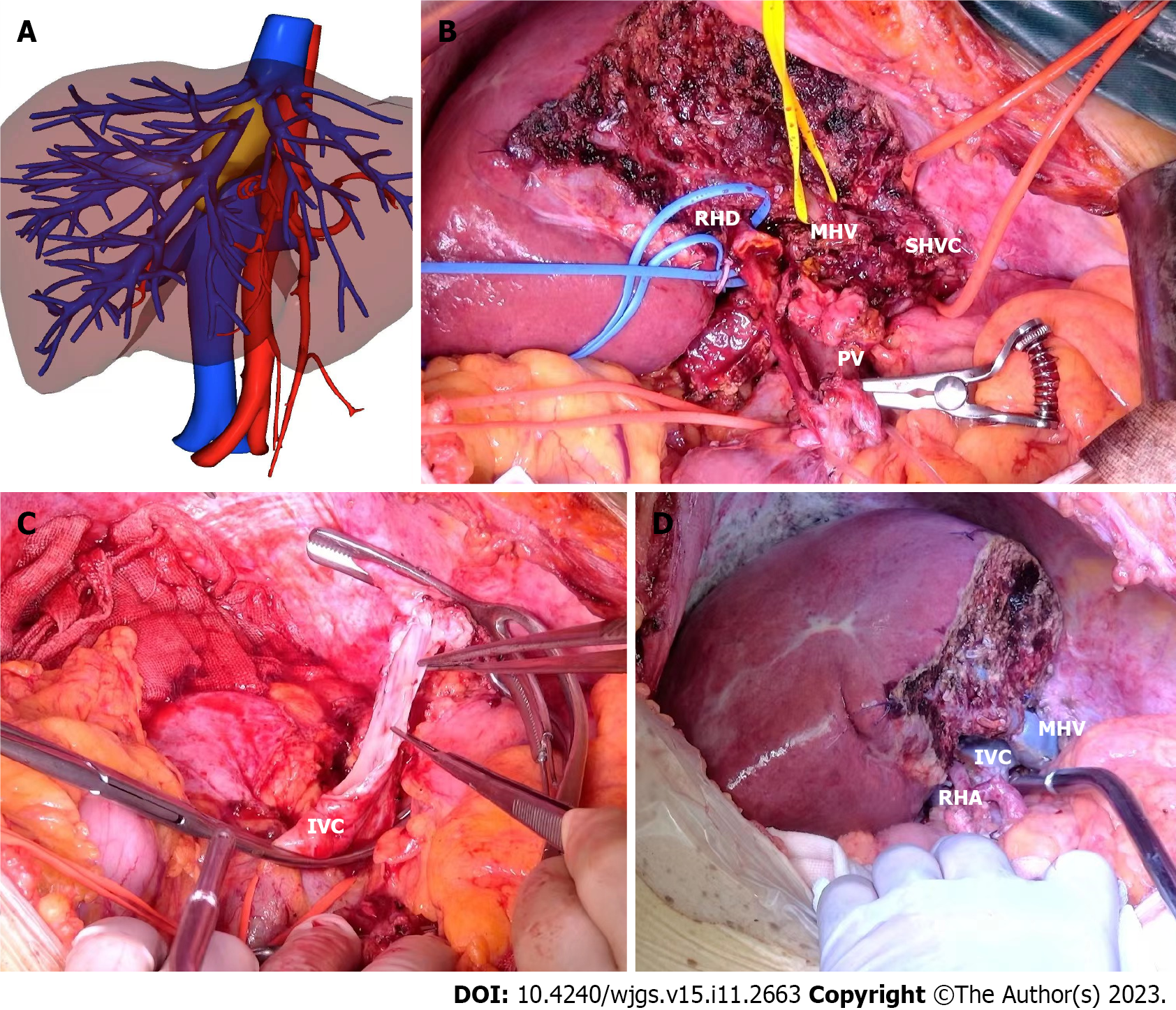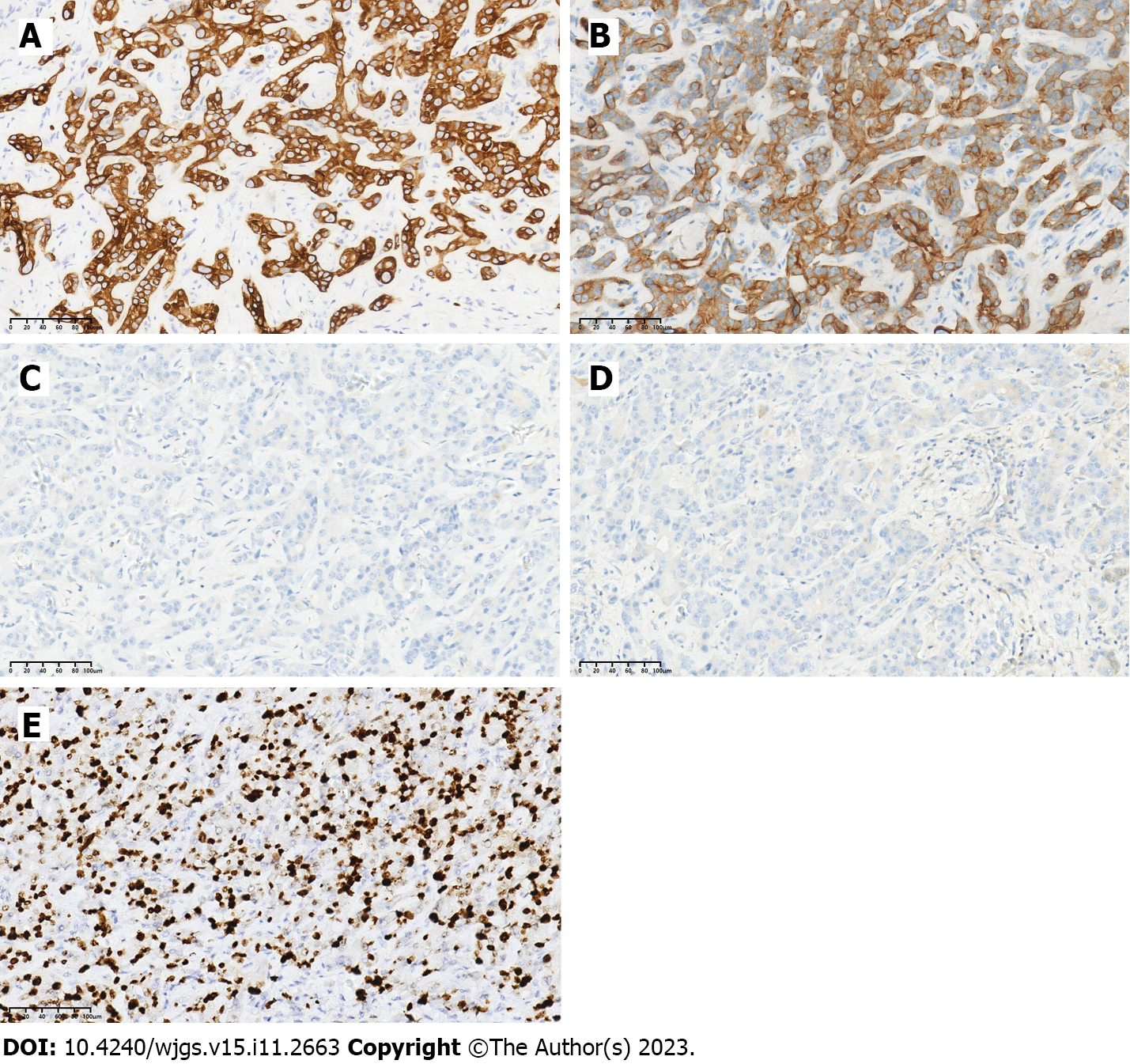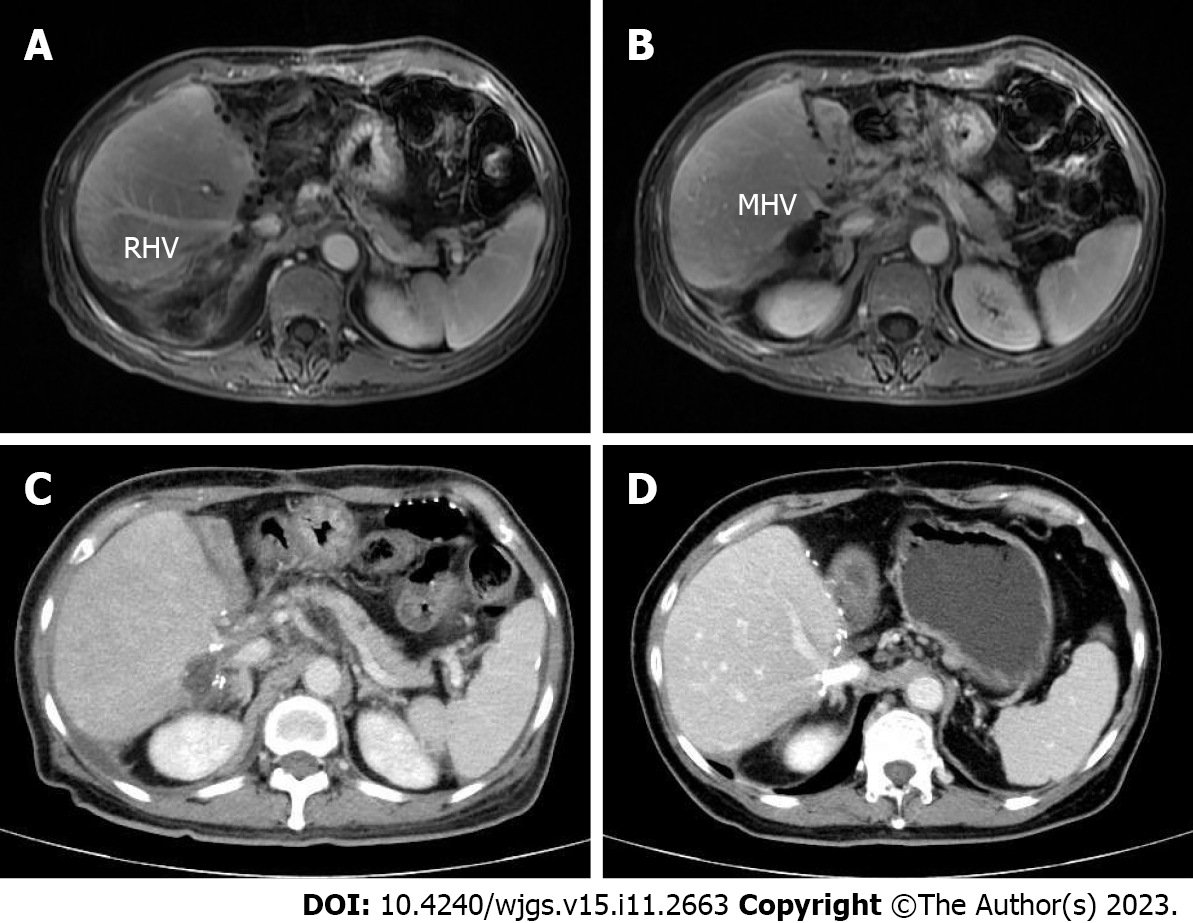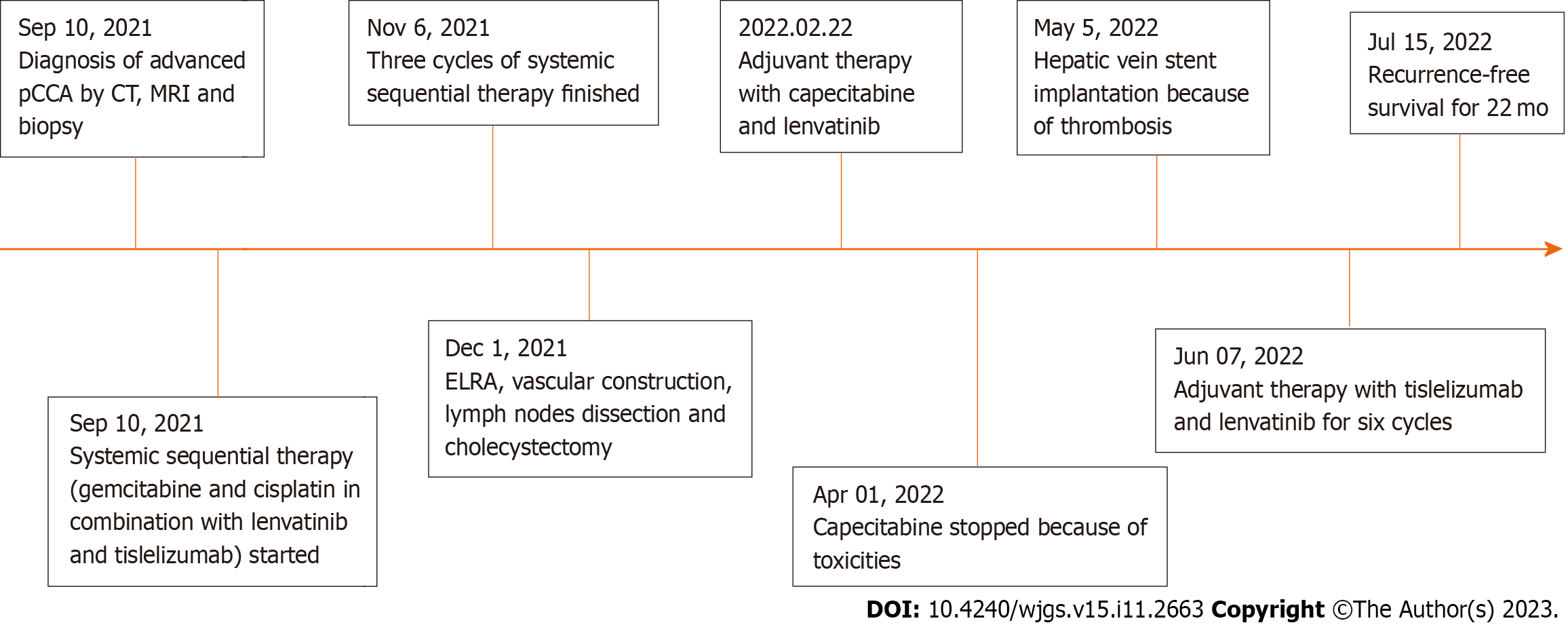Published online Nov 27, 2023. doi: 10.4240/wjgs.v15.i11.2663
Peer-review started: August 29, 2023
First decision: September 23, 2023
Revised: September 30, 2023
Accepted: October 25, 2023
Article in press: October 25, 2023
Published online: November 27, 2023
Processing time: 90 Days and 6.6 Hours
Perihilar cholangiocarcinoma (pCCA) is a highly malignant tumor arising from the biliary tree. Radical surgery is the only treatment offering a chance of long-term survival. However, limited by the tumor’s anatomic location and peri-vascular invasion, most patients lose the chance for curative treatment. Therefore, more methods to increase the resectability of tumors as well as to improve outcomes are needed.
A 68-year-old female patient had a hepatic hilar mass without obvious symptoms. Laboratory results showed hepatitis B positivity. Magnetic resonance imaging indicated that the mass (maximum diameter: 41 mm) invaded the left and right branches of the main portal vein, as well as the middle, left and right hepatic veins; enlarged lymph nodes were also detected in the hilum. The patient was diagnosed with pCCA, and the clinical stage was determined to be T4N1M0 (stage IIIC). Considering the tumor’s anatomic location and vascular invasion, systematic conversion therapy followed by ex vivo liver resection and autotransplantation (ELRA) was determined as personalized treatment for this patient. Our original systemic sequential therapeutic strategy (lenvatinib and tislelizumab in combination with gemcitabine and cisplatin) was successfully adopted as conversion therapy because she achieved partial response after three cycles of treatment, without severe toxicity. ELRA, anastomotic reconstruction of the middle hepatic vein, right hepatic vein, root of portal vein, inferior vena cava and right hepatic artery, and lymph node dissection were performed at one month after systemic therapy. Pathological and immunohistochemical examination confirmed the diagnosis of pCCA with lymph node metastasis. Although the middle hepatic vein was partially obstructed four months later, hepatic vein stent implantation successfully addressed this problem. The patient has survived for 22 mo after the diagnosis, with no evidence of recurrence or metastasis.
An effective therapeutic strategy for conversion therapy greatly increases the feasibility and efficiency of ELRA.
Core Tip: Limited by tumor’s anatomic location and peri-vascular invasion, most perihilar cholangiocarcinoma patients lose the chance for curative treatment. In this case, we originally put forward systematic conversion therapy followed by ex vivo liver resection and autotransplantation (ELRA). The patient achieved partial response after three cycles of systemic sequential treatment without severe toxicities. Soon afterwards, ELRA, anastomotic reconstruction of the middle hepatic vein, the right hepatic vein, the root of portal vein, inferior vena cava and right hepatic artery, and lymph node dissection were performed with success. The patient achieved long time survival and has survived 22 mo following diagnosis with no evidence of recurrence or metastasis.
- Citation: Hu CL, Han X, Gao ZZ, Zhou B, Tang JL, Pei XR, Lu JN, Xu Q, Shen XP, Yan S, Ding Y. Systematic sequential therapy for ex vivo liver resection and autotransplantation: A case report and review of literature. World J Gastrointest Surg 2023; 15(11): 2663-2673
- URL: https://www.wjgnet.com/1948-9366/full/v15/i11/2663.htm
- DOI: https://dx.doi.org/10.4240/wjgs.v15.i11.2663
Originating from the biliary tree and/or within the hepatic parenchyma, cholangiocarcinoma (CCA) is a highly lethal epithelial cell malignancy. CCA predominantly arises from bile duct epithelial cells and displays features of cholangiocyte differentiation[1]. These heterogeneous cancers can be classified according to anatomic subtype as intrahepatic CCA (iCCA), perihilar CCA (pCCA) or distal CCA (dCCA). pCCA is localized between the second-order bile ducts and the junction of the cystic duct into the common bile duct, dCCA is confined to the common bile duct below the cystic duct insertion, and iCCA is located within the liver parenchyma[2,3]. Each of the anatomic subtypes is characterized by unique genetic aberrations, clinical presentations and management options.
As the most common subtype of CCA, pCCA accounts for more than 50% of cases, and radical surgical resection is the only treatment offering a chance of long-term survival for patients with pCCA[4]. Unfortunately, due to its highly invasive biological characteristics and lack of specific symptoms, most pCCA patients are diagnosed with advanced disease, which decreases the opportunity of radical surgery[5]. In addition, extensive hilar invasion, liver involvement and vascular encasement often preclude curative resection. Therefore, the traditional surgical effect is far from satisfactory; liver transplantation may be a more promising option for pCCA patients[6].
In 1988, ex vivo liver resection and autotransplantation (ELRA) was first introduced by Professor Pichlmayr et al[7] as an alternative to liver transplantation for unresectable hepatic tumors, and ELRA has been constantly developed to improve the resectability of hepatobiliary malignancies. In 2003, Chui et al[8] first reported a type IV pCCA patient who underwent ELRA and survived for two years without any sign of tumor recurrence. Currently, the rapid development of autologous liver transplantation surgical techniques and vascular reconstruction techniques as well as the application of novel immunosuppressive agents are greatly contributing to expanding the limits of resectability and reducing the incidence of chronic allograft rejection, which may greatly benefit select patients[9,10]. However, because of the rigorous admission criteria for liver transplantation, more methods to increase the feasibility of ELRA are needed[11].
Recently, conversion therapy using systematic therapy and/or nonsurgical local therapy to inhibit tumor progression, reduce the tumor burden, and even decrease TNM staging has provided patients with the opportunity for radical surgery and significantly improved prognosis[1,12,13]. In 2021, we first reported that an original systemic sequential therapeutic strategy (gemcitabine 1000 mg/m2 and cisplatin 25 mg/m2 on days 1 and 8; lenvatinib 8 mg/d from days 1 to 21; tislelizumab 200 mg on day 15) showed reliable treatment effects on conversion surgery for advanced iCCA patients[14]. Here, we present our new single-center experience with this conversion therapy strategy for treatment of pCCA before ELRA. The prognosis of our 68-year-old female patient was favorable, and no evidence of tumor recurrence was found until July 15, 2023.
A 68-year-old female patient was incidentally found to have a mass in the second hepatic portal region to the caudate lobe at a local hospital and was admitted to our hospital for treatment on August 30, 2021.
No special discomfort was reported by the patient.
None.
None.
No signs were detected by physical examination.
No abnormal laboratory results were recorded, except for alanine aminotransferase (ALT) 43 U/L and aspartate aminotransferase (AST) 46 U/L; anti-HBs (+), anti-HBe (+) and anti-HBc (+) were also obtained. We performed liver biopsy, and the results revealed moderately poorly differentiated adenocarcinoma (Figure 1A and B). Immunohistochemical staining results were as follows: CK7 (+), CK19 (+), HepPar-1 (-), arginase-1 (-) and Ki-67 labeling index 40%.
B-scan ultrasound showed a hilar mass that led to expansion of the intrahepatic bile duct in the left lobe of the liver. Contrast-enhanced magnetic resonance imaging (MRI) scanning found that the mass (maximum diameter: 41 mm) invaded the left and right branches of the main portal vein as well as the middle, left and right hepatic veins (Figure 2A-D). Enlarged hilar lymph nodes were also detected by MRI (Figure 2E). However, there was no invasion of the abdominal aorta or its branches and no filling defect in the inferior vena cava according to computed tomography (CT) imaging of abdominal vessels.
We made a diagnosis of pCCA with lymph node metastasis. The Child-Pugh score was A with 5 points. The TNM clinical stage was determined as T4N1M0 (stage IIIC) according to the American Joint Committee on Cancer staging system, 8th edition.
After full consideration, we determined that the patient had lost the chance for surgery and was scheduled for a personalized therapeutic scheme (intravenous gemcitabine 1000 mg/m2 and cisplatin 25 mg/m2 on day 1, day 8; oral lenvatinib 8 mg/d from day 1 to day 21; intravenous tislelizumab 200 mg on day 15). No grade 3/4 treatment-related adverse effects were detected after three cycles of systemic treatment. Further MRI indicated that the mass in the hilar was significantly smaller than that previously (Figure 2F-I). The diameter of the largest lesion had decreased from 41 mm to 21 mm. According to the standard RECIST 1.1 criteria, the patient successfully achieved partial response (PR), and the lymph nodes in the hilar region were also smaller than before (Figure 2J). Consequently, the preoperative multidisciplinary team carefully reviewed all preoperative results and proposed a surgical strategy for autologous liver segment autotransplantation.
The surgery was performed on December 1, 2021, and lasted for 740 min. Three-dimensional reconstruction (Figure 3A) and intraoperative exploration revealed that the tumor invaded the root of the left and right hepatic ducts, left and right portal veins, and middle and right hepatic veins. First, the left hemiliver was completely removed in vivo, and the middle hepatic vein was retained in the right lobe (Figure 3B). When the right lobe including the tumor was resected (Figure 3C), the right lobe was immediately placed in an ice basin and perfused with 4°C histidine-tryptophan-ketoglutarate solution. In vitro, the tumor was completely resected, and we further used the allogeneic iliac vein to lengthen the middle and right hepatic veins. In addition, the allogeneic iliac vein was used as the bypass between the portal vein and inferior vena cava during the anhepatic phase. Finally, anastomotic reconstruction of the middle hepatic vein, the right hepatic vein, the root of portal vein, inferior vena cava, and right hepatic artery were performed sequentially (Figure 3D). Moreover, the hepatic portal lymph nodes and para-esophageal lymph nodes were dissected.
Postoperative pathological examination (Figure 1C and D) showed the following: The tumor bed with a large necrotic area, interstitial fibrosis and tumor residue was 4.0 cm × 3.0 cm in size as well as a negative surgical margin; the hepatic portal lymph nodes were 0/3 positive, but the para-esophageal lymph nodes were 2/2 positive; no microvascular or Glisson's capsule invasion was found. Results of immunohistochemical analysis were as follows: CK7 (+), CK19 (+), HepPar-1 (-), Arginase-1(-) and Ki-67 labeling index 80% (Figure 4). The patient was sent to the intensive care unit and extubated on postoperative day 2. Tacrolimus (0.5 mg, QD7; 1 mg, QD19) was administered to prevent immune rejection, and the value of FK506 was closely monitored. According to postoperative ultrasound, the maximum blood flow velocities of the portal vein, hepatic artery, right hepatic vein and middle hepatic vein were 40.64 cm/s, 70.96 cm/s, 69.02 cm/s and 23.22 cm/s, respectively. No severe complications occurred during hospitalization. The patient was successfully discharged on postoperative day 22 with normal liver and heart function.
At 2 mo after the surgery, the patient continued to take oral capecitabine (1750 mg, twice daily) and lenvatinib (8 mg, once daily) as maintenance treatments. At a 3 mo follow-up, the patient felt subjectively well, and no obvious abnormity was found by contrast-enhanced MRI re-examination (Figure 5A and B). Unfortunately, abdominal enhanced CT indicated the existence of hepatic congestion and hepatomegaly on April 19, 2022 (Figure 5C). Her liver function and coagulation function were abnormal, showing the following: ALT 52 U/L, AST 92 U/L, total bilirubin 40.3 μmol/L, direct bilirubin 17.5 μmol/L, indirect bilirubin 22.8 μmol/L, albumin 32.1 g/L, and serum D-dimer 1040 μg/L. Furthermore, the middle hepatic vein was partially obstructed, and the maximum blood flow velocities of the portal vein, hepatic artery, right hepatic vein and middle hepatic vein were significantly slower than before. Considering that a thrombus may further impair liver function, the patient underwent hepatic vein stent implantation on May 5, 2022. After treatment, her liver function returned to normal levels. Postoperative ultrasonography indicated that blood flow in the stent was clear, and the maximum blood flow velocity of the stenting area was 118.8 cm/s.
One month later, the patient received six cycles of targeted therapy and immunotherapy (lenvatinib 8 mg/d from day 1 to day 21; tislelizumab 200 mg on day 15). Further follow-ups showed no evidence of local recurrence or distant metastasis, and the hepatic vein stent was good (Figure 5D). To date, the patient has survived well without any severe discomfort for more than 22 mo. Figure 6 shows this patient’s timeline of initial diagnosis, systemic therapy, surgery, adjuvant therapy and follow-up.
Currently, pCCA is a malignancy with the most dismal prognoses, and the gold standard curative therapy is radical resection. Unfortunately, less than 50% of pCCA patients are eligible for resection[15], and the incidence of R0 resection reported in patients undergoing surgery is only 45%[16]. A need for improvement in tumor resectability and resection safety therefore seems obvious. Of note, in contrast to liver resection, liver transplantation is logically an attractive alternative to address most problems, such as the high potential of residual tumor as well as unresectable disease with vascular involvement[6]. ELRA, a unique type of liver transplantation, provides several benefits. It may improve tumor accessibility to achieve complete tumor resection with clear margins, achieve complex vascular reconstruction, reduce ischemic damage to the organ through use of cold preservation solution, decrease demand for organ donors and reduce immunosuppression compared with allotransplantation[17]. In recent years, there have been numerous reports related to successful treatment with ELRA[9,18-21]. Based on their large collective experience, Weiner et al[9] reported relatively favorable outcomes after ELRA in select patients. A systematic review and meta-analysis revealed an R0 resection rate of 93.4% and a 1-year survival of 78.4% with ELRA[22]. In addition, one study demonstrated that liver transplantation for pCCA led to similar or even better outcomes than with hepatocellular carcinoma or cirrhosis due to various causes[23]. Therefore, ELRA may become a more widely accepted and practical treatment option for conventionally unresectable hepatobiliary tumors.
However, not all patients are eligible for ELRA. Ideal candidates are those with good functional reserve, can tolerate the procedures, and have a less aggressive malignant tumor[17]. According to data from the Mayo Clinic, a mass not larger than 3 cm in diameter is the selection criterion for pCCA[24]. In our case, the malignancy was 4.1 cm in diameter, and the tumor was located in the porta hepatis with involvement of the middle hepatic vein, portal vein and inferior vena cava. Although ELRA and vascular reconstruction may offer R0 resection and excellent survival, the patient did not have sufficient indications. Hence, it was crucial to reduce the tumor burden by some effective means before ELRA to allow the patient to obtain more benefits.
Based on our center’s experience, conversion therapy[25] involving multidisciplinary systematic treatment preoperatively and aiming to render the tumor more amenable to surgical removal can be regarded as a more suitable pre-ELRA treatment for this patient. At present, there are various systematic treatment strategies. Over the last decade, doublet chemotherapy with gemcitabine and cisplatin has been considered the most effective first-line treatment for pCCA, as based on the results of the ABC-02 trial (NCT00262769) reported in 2010[26]. In the new era of targeted therapy and immunotherapy, systemic therapy with molecular and immune therapies has dramatically changed management of pCCA at advanced stages. Notably, the randomized, double-blind, phase 3 TOPAZ-1 trial (NCT03875235) showed that adding the PD-L1 inhibitor durvalumab to gemcitabine and cisplatin significantly improved overall survival (OS) for advanced biliary tract cancer (BTC) compared with gemcitabine and cisplatin alone: Median OS: 12.8 mo [95% confidence interval (95%CI): 11.1-14.0] vs. 11.5 mo (95%CI: 10.1-12.5); hazard ratio (HR) 0.80; two-sided P = 0.021[27]. Another recent phase 3 clinical trial (KEYNOTE-966; NCT04003636) found that adding pembrolizumab to gemcitabine and cisplatin remarkably ameliorated OS for advanced BTC [median OS: 12.7 mo (95%CI: 11.5-13.6) in the pembrolizumab group vs. 10.9 mo (95%CI: 9.9-11.6) in the placebo group; HR 0.83; one-sided P = 0.0034][28]. Thus, combination chemotherapy and immunotherapy are safe and effective for patients with pCCA.
Lenvatinib, a multikinase inhibitor that targets vascular endothelial growth factor (VEGF) receptor 1-3, fibroblast growth factor receptor 1-4, platelet-derived growth factor receptor-α, RET, and KIT, is widely used for many solid tumors, especially hepatobiliary malignancies[29-33]. More than 50% VEGF overexpression is detected in CCA[34]. Based on this evidence, we deeply considered whether systematic therapy, including chemotherapy, targeted therapy and immunotherapy, is sensible for CCA patients. We first reported based on our previous clinical practice that systemic sequential therapy with gemcitabine, cisplatin, lenvatinib and tislelizumab offers great therapeutic effects for preoperative advanced iCCA conversion therapy[14]. Zhang et al[35] reported a patient with iCCA who first received six cycles of conversion therapy (gemcitabine 1000 mg/m2 and cisplatin 25 mg/m2 on day 1 and day 8; pembrolizumab, 200 mg every 3 wk; lenvatinib 8 mg from day 1 to day 21) and achieved pathologic PR without severe toxicity, followed by radical liver resection, cholecystectomy and hilar lymph node dissection. A single-arm phase 2 study (NCT03951597) to explore the efficacy and safety of a similar systemic sequential therapy for iCCA was completed in 2022[36]. The objective response rate was 80% and the median OS 22.5 mo (95%CI: 15.6-29.3) after combination therapy of toripalimab, lenvatinib, and gemcitabine plus oxaliplatin for advanced iCCA when the median follow-up time was 23.5 mo. In our case, our previous systemic sequential therapy (gemcitabine 1000 mg/m2 and cisplatin 25 mg/m2 on day 1 and day 8; lenvatinib 8 mg from day 1 to day 21; tislelizumab 200 mg on day 15) was successfully administered to a pCCA patient as conversion therapy, without any grade 3/4 adverse effects, before ELRA and allogeneic vascular reconstruction. The old patients ultimately achieved excellent outcomes.
In conclusion, this is the first case report of a novel systemic sequential therapeutic strategy followed by ELRA and vascular reconstruction for pCCA. The female patient achieved PR after the scheduled therapy, and no obvious overlapping toxicities occurred during that period. Considering the tumor’s anatomic location and vascular invasion, ELRA and vascular reconstruction was considered to be a better treatment option. The tumor was successfully resected ex vivo with a negative surgical margin; the hepatic vein and inferior vena cava were smoothly reconstructed with the allogeneic iliac vein. This case indicates that an effective therapeutic strategy for conversion therapy can greatly increase the feasibility and efficiency of ELRA and vascular reconstruction. Currently, our phase 2 clinical trial (NCT05532059), designed to explore the efficacy and safety of this systemic therapy for CCA patients, is ongoing, and we hope to provide more beneficial treatment options for advanced CCA.
Provenance and peer review: Unsolicited article; Externally peer reviewed.
Peer-review model: Single blind
Specialty type: Gastroenterology and hepatology
Country/Territory of origin: China
Peer-review report’s scientific quality classification
Grade A (Excellent): A
Grade B (Very good): 0
Grade C (Good): C
Grade D (Fair): 0
Grade E (Poor): 0
P-Reviewer: Lang SA, Germany; Zharikov YO, Russia S-Editor: Lin C L-Editor: A P-Editor: Lin C
| 1. | Brindley PJ, Bachini M, Ilyas SI, Khan SA, Loukas A, Sirica AE, Teh BT, Wongkham S, Gores GJ. Cholangiocarcinoma. Nat Rev Dis Primers. 2021;7:65. [RCA] [PubMed] [DOI] [Full Text] [Cited by in Crossref: 100] [Cited by in RCA: 470] [Article Influence: 117.5] [Reference Citation Analysis (0)] |
| 2. | Banales JM, Marin JJG, Lamarca A, Rodrigues PM, Khan SA, Roberts LR, Cardinale V, Carpino G, Andersen JB, Braconi C, Calvisi DF, Perugorria MJ, Fabris L, Boulter L, Macias RIR, Gaudio E, Alvaro D, Gradilone SA, Strazzabosco M, Marzioni M, Coulouarn C, Fouassier L, Raggi C, Invernizzi P, Mertens JC, Moncsek A, Rizvi S, Heimbach J, Koerkamp BG, Bruix J, Forner A, Bridgewater J, Valle JW, Gores GJ. Cholangiocarcinoma 2020: the next horizon in mechanisms and management. Nat Rev Gastroenterol Hepatol. 2020;17:557-588. [RCA] [PubMed] [DOI] [Full Text] [Full Text (PDF)] [Cited by in Crossref: 1555] [Cited by in RCA: 1551] [Article Influence: 310.2] [Reference Citation Analysis (0)] |
| 3. | Moris D, Palta M, Kim C, Allen PJ, Morse MA, Lidsky ME. Advances in the treatment of intrahepatic cholangiocarcinoma: An overview of the current and future therapeutic landscape for clinicians. CA Cancer J Clin. 2023;73:198-222. [RCA] [PubMed] [DOI] [Full Text] [Cited by in Crossref: 262] [Cited by in RCA: 259] [Article Influence: 129.5] [Reference Citation Analysis (0)] |
| 4. | Halder R, Amaraneni A, Shroff RT. Cholangiocarcinoma: a review of the literature and future directions in therapy. Hepatobiliary Surg Nutr. 2022;11:555-566. [RCA] [PubMed] [DOI] [Full Text] [Full Text (PDF)] [Cited by in RCA: 27] [Reference Citation Analysis (0)] |
| 5. | Elvevi A, Laffusa A, Scaravaglio M, Rossi RE, Longarini R, Stagno AM, Cristoferi L, Ciaccio A, Cortinovis DL, Invernizzi P, Massironi S. Clinical treatment of cholangiocarcinoma: an updated comprehensive review. Ann Hepatol. 2022;27:100737. [RCA] [PubMed] [DOI] [Full Text] [Cited by in Crossref: 85] [Cited by in RCA: 86] [Article Influence: 28.7] [Reference Citation Analysis (0)] |
| 6. | Breuer E, Mueller M, Doyle MB, Yang L, Darwish Murad S, Anwar IJ, Merani S, Limkemann A, Jeddou H, Kim SC, López-López V, Nassar A, Hoogwater FJH, Vibert E, De Oliveira ML, Cherqui D, Porte RJ, Magliocca JF, Fischer L, Fondevila C, Zieniewicz K, Ramírez P, Foley DP, Boudjema K, Schenk AD, Langnas AN, Knechtle S, Polak WG, Taner CB, Chapman WC, Rosen CB, Gores GJ, Dutkowski P, Heimbach JK, Clavien PA. Liver Transplantation as a New Standard of Care in Patients With Perihilar Cholangiocarcinoma? Results From an International Benchmark Study. Ann Surg. 2022;276:846-853. [RCA] [PubMed] [DOI] [Full Text] [Full Text (PDF)] [Cited by in Crossref: 7] [Cited by in RCA: 46] [Article Influence: 15.3] [Reference Citation Analysis (0)] |
| 7. | Pichlmayr R, Bretschneider HJ, Kirchner E, Ringe B, Lamesch P, Gubernatis G, Hauss J, Niehaus KJ, Kaukemüller J. [Ex situ operation on the liver. A new possibility in liver surgery]. Langenbecks Arch Chir. 1988;373:122-126. [RCA] [PubMed] [DOI] [Full Text] [Cited by in Crossref: 99] [Cited by in RCA: 95] [Article Influence: 2.6] [Reference Citation Analysis (0)] |
| 8. | Chui AK, Island ER, Rao AR, Lau WY. The longest survivor and first potential cure of an advanced cholangiocarcinoma by ex vivo resection and autotransplantation: a case report and review of the literature. Am Surg. 2003;69:441-444. [PubMed] |
| 9. | Weiner J, Hemming A, Levi D, Beduschi T, Matsumoto R, Mathur A, Liou P, Griesemer A, Samstein B, Cherqui D, Emond J, Kato T. Ex Vivo Liver Resection and Autotransplantation: Should It be Used More Frequently? Ann Surg. 2022;276:854-859. [RCA] [PubMed] [DOI] [Full Text] [Cited by in RCA: 14] [Reference Citation Analysis (0)] |
| 10. | Jadlowiec CC, Taner T. Liver transplantation: Current status and challenges. World J Gastroenterol. 2016;22:4438-4445. [RCA] [PubMed] [DOI] [Full Text] [Full Text (PDF)] [Cited by in CrossRef: 238] [Cited by in RCA: 211] [Article Influence: 23.4] [Reference Citation Analysis (2)] |
| 11. | Terrault NA, Francoz C, Berenguer M, Charlton M, Heimbach J. Liver Transplantation 2023: Status Report, Current and Future Challenges. Clin Gastroenterol Hepatol. 2023;21:2150-2166. [RCA] [PubMed] [DOI] [Full Text] [Cited by in Crossref: 6] [Cited by in RCA: 134] [Article Influence: 67.0] [Reference Citation Analysis (0)] |
| 12. | Kovalenko YA, Zharikov YO, Konchina NA, Gurmikov BN, Marinova LA, Zhao AV. Perihilar cholangiocarcinoma: A different concept for radical resection. Surg Oncol. 2020;33:270-275. [RCA] [PubMed] [DOI] [Full Text] [Cited by in Crossref: 12] [Cited by in RCA: 2] [Article Influence: 0.4] [Reference Citation Analysis (0)] |
| 13. | Sun HC, Zhou J, Wang Z, Liu X, Xie Q, Jia W, Zhao M, Bi X, Li G, Bai X, Ji Y, Xu L, Zhu XD, Bai D, Chen Y, Dai C, Guo R, Guo W, Hao C, Huang T, Huang Z, Li D, Li T, Li X, Liang X, Liu J, Liu F, Lu S, Lu Z, Lv W, Mao Y, Shao G, Shi Y, Song T, Tan G, Tang Y, Tao K, Wan C, Wang G, Wang L, Wang S, Wen T, Xing B, Xiang B, Yan S, Yang D, Yin G, Yin T, Yin Z, Yu Z, Zhang B, Zhang J, Zhang S, Zhang T, Zhang Y, Zhang A, Zhao H, Zhou L, Zhang W, Zhu Z, Qin S, Shen F, Cai X, Teng G, Cai J, Chen M, Li Q, Liu L, Wang W, Liang T, Dong J, Chen X, Wang X, Zheng S, Fan J; Alliance of Liver Cancer Conversion Therapy, Committee of Liver Cancer of the Chinese Anti-Cancer Association. Chinese expert consensus on conversion therapy for hepatocellular carcinoma (2021 edition). Hepatobiliary Surg Nutr. 2022;11:227-252. [RCA] [PubMed] [DOI] [Full Text] [Cited by in Crossref: 71] [Cited by in RCA: 116] [Article Influence: 38.7] [Reference Citation Analysis (0)] |
| 14. | Ding Y, Han X, Sun Z, Tang J, Wu Y, Wang W. Systemic Sequential Therapy of CisGem, Tislelizumab, and Lenvatinib for Advanced Intrahepatic Cholangiocarcinoma Conversion Therapy. Front Oncol. 2021;11:691380. [RCA] [PubMed] [DOI] [Full Text] [Full Text (PDF)] [Cited by in Crossref: 1] [Cited by in RCA: 7] [Article Influence: 1.8] [Reference Citation Analysis (0)] |
| 15. | Dondossola D, Ghidini M, Grossi F, Rossi G, Foschi D. Practical review for diagnosis and clinical management of perihilar cholangiocarcinoma. World J Gastroenterol. 2020;26:3542-3561. [RCA] [PubMed] [DOI] [Full Text] [Full Text (PDF)] [Cited by in CrossRef: 29] [Cited by in RCA: 41] [Article Influence: 8.2] [Reference Citation Analysis (2)] |
| 16. | Mueller M, Breuer E, Mizuno T, Bartsch F, Ratti F, Benzing C, Ammar-Khodja N, Sugiura T, Takayashiki T, Hessheimer A, Kim HS, Ruzzenente A, Ahn KS, Wong T, Bednarsch J, D'Silva M, Koerkamp BG, Jeddou H, López-López V, de Ponthaud C, Yonkus JA, Ismail W, Nooijen LE, Hidalgo-Salinas C, Kontis E, Wagner KC, Gunasekaran G, Higuchi R, Gleisner A, Shwaartz C, Sapisochin G, Schulick RD, Yamamoto M, Noji T, Hirano S, Schwartz M, Oldhafer KJ, Prachalias A, Fusai GK, Erdmann JI, Line PD, Smoot RL, Soubrane O, Robles-Campos R, Boudjema K, Polak WG, Han HS, Neumann UP, Lo CM, Kang KJ, Guglielmi A, Park JS, Fondevila C, Ohtsuka M, Uesaka K, Adam R, Pratschke J, Aldrighetti L, De Oliveira ML, Gores GJ, Lang H, Nagino M, Clavien PA. Perihilar Cholangiocarcinoma - Novel Benchmark Values for Surgical and Oncological Outcomes From 24 Expert Centers. Ann Surg. 2021;274:780-788. [RCA] [PubMed] [DOI] [Full Text] [Cited by in Crossref: 114] [Cited by in RCA: 108] [Article Influence: 27.0] [Reference Citation Analysis (0)] |
| 17. | Hwang R, Liou P, Kato T. Ex vivo liver resection and autotransplantation: An emerging option in selected indications. J Hepatol. 2018;69:1002-1003. [RCA] [PubMed] [DOI] [Full Text] [Cited by in Crossref: 14] [Cited by in RCA: 16] [Article Influence: 2.3] [Reference Citation Analysis (0)] |
| 18. | Aji T, Dong JH, Shao YM, Zhao JM, Li T, Tuxun T, Shalayiadang P, Ran B, Jiang TM, Zhang RQ, He YB, Huang JF, Wen H. Ex vivo liver resection and autotransplantation as alternative to allotransplantation for end-stage hepatic alveolar echinococcosis. J Hepatol. 2018;69:1037-1046. [RCA] [PubMed] [DOI] [Full Text] [Cited by in Crossref: 59] [Cited by in RCA: 77] [Article Influence: 11.0] [Reference Citation Analysis (0)] |
| 19. | Kato T, Hwang R, Liou P, Weiner J, Griesemer A, Samstein B, Halazun K, Mathur A, Schwartz G, Cherqui D, Emond J. Ex Vivo Resection and Autotransplantation for Conventionally Unresectable Tumors - An 11-year Single Center Experience. Ann Surg. 2020;272:766-772. [RCA] [PubMed] [DOI] [Full Text] [Cited by in Crossref: 6] [Cited by in RCA: 23] [Article Influence: 4.6] [Reference Citation Analysis (0)] |
| 20. | Qiu Y, Huang B, Yang X, Wang T, Shen S, Yang Y, Wang W. Evaluating the Benefits and Risks of Ex Vivo Liver Resection and Autotransplantation in Treating Hepatic End-stage Alveolar Echinococcosis. Clin Infect Dis. 2022;75:1289-1296. [RCA] [PubMed] [DOI] [Full Text] [Cited by in Crossref: 1] [Cited by in RCA: 11] [Article Influence: 3.7] [Reference Citation Analysis (0)] |
| 21. | Baimas-George MR, Levi DM, Vrochides D. Three Possible Variations in Ex Vivo Hepatectomy: Achieving R0 Resection by Auto-transplantation. J Gastrointest Surg. 2019;23:2294-2297. [RCA] [PubMed] [DOI] [Full Text] [Cited by in Crossref: 8] [Cited by in RCA: 7] [Article Influence: 1.2] [Reference Citation Analysis (0)] |
| 22. | Zawistowski M, Nowaczyk J, Jakubczyk M, Domagała P. Outcomes of ex vivo liver resection and autotransplantation: A systematic review and meta-analysis. Surgery. 2020;168:631-642. [RCA] [PubMed] [DOI] [Full Text] [Cited by in Crossref: 16] [Cited by in RCA: 29] [Article Influence: 5.8] [Reference Citation Analysis (0)] |
| 23. | Muller X, Marcon F, Sapisochin G, Marquez M, Dondero F, Rayar M, Doyle MMB, Callans L, Li J, Nowak G, Allard MA, Jochmans I, Jacskon K, Beltrame MC, van Reeven M, Iesari S, Cucchetti A, Sharma H, Staiger RD, Raptis DA, Petrowsky H, de Oliveira M, Hernandez-Alejandro R, Pinna AD, Lerut J, Polak WG, de Santibañes E, de Santibañes M, Cameron AM, Pirenne J, Cherqui D, Adam RA, Ericzon BG, Nashan B, Olthoff K, Shaked A, Chapman WC, Boudjema K, Soubrane O, Paugam-Burtz C, Greig PD, Grant DR, Carvalheiro A, Muiesan P, Dutkowski P, Puhan M, Clavien PA. Defining Benchmarks in Liver Transplantation: A Multicenter Outcome Analysis Determining Best Achievable Results. Ann Surg. 2018;267:419-425. [RCA] [PubMed] [DOI] [Full Text] [Cited by in Crossref: 97] [Cited by in RCA: 197] [Article Influence: 28.1] [Reference Citation Analysis (0)] |
| 24. | Darwish Murad S, Kim WR, Harnois DM, Douglas DD, Burton J, Kulik LM, Botha JF, Mezrich JD, Chapman WC, Schwartz JJ, Hong JC, Emond JC, Jeon H, Rosen CB, Gores GJ, Heimbach JK. Efficacy of neoadjuvant chemoradiation, followed by liver transplantation, for perihilar cholangiocarcinoma at 12 US centers. Gastroenterology. 2012;143:88-98.e3; quiz e14. [RCA] [PubMed] [DOI] [Full Text] [Cited by in Crossref: 378] [Cited by in RCA: 395] [Article Influence: 30.4] [Reference Citation Analysis (0)] |
| 25. | Jiang C, Sun XD, Qiu W, Chen YG, Sun DW, Lv GY. Conversion therapy in liver transplantation for hepatocellular carcinoma: What's new in the era of molecular and immune therapy? Hepatobiliary Pancreat Dis Int. 2023;22:7-13. [RCA] [PubMed] [DOI] [Full Text] [Cited by in Crossref: 1] [Cited by in RCA: 13] [Article Influence: 6.5] [Reference Citation Analysis (0)] |
| 26. | Valle J, Wasan H, Palmer DH, Cunningham D, Anthoney A, Maraveyas A, Madhusudan S, Iveson T, Hughes S, Pereira SP, Roughton M, Bridgewater J; ABC-02 Trial Investigators. Cisplatin plus gemcitabine versus gemcitabine for biliary tract cancer. N Engl J Med. 2010;362:1273-1281. [RCA] [PubMed] [DOI] [Full Text] [Cited by in Crossref: 2617] [Cited by in RCA: 3169] [Article Influence: 211.3] [Reference Citation Analysis (1)] |
| 27. | Oh D-Y, He AR, Qin S, Chen L-T, Okusaka T, Vogel A, Kim JW, Suksombooncharoen T, Lee MA, Kitano M, III HAB, Bouattour M, Tanasanvimon S, Zaucha R, Avallone A, Cundom J, Rokutanda N, Xiong J, Cohen G, Valle JW. A phase 3 randomized, double-blind, placebo-controlled study of durvalumab in combination with gemcitabine plus cisplatin (GemCis) in patients (pts) with advanced biliary tract cancer (BTC): TOPAZ-1. J Clin Oncol. 2022;40:378-78. [RCA] [DOI] [Full Text] [Cited by in Crossref: 46] [Cited by in RCA: 57] [Article Influence: 19.0] [Reference Citation Analysis (0)] |
| 28. | Kelley RK, Ueno M, Yoo C, Finn RS, Furuse J, Ren Z, Yau T, Klümpen HJ, Chan SL, Ozaka M, Verslype C, Bouattour M, Park JO, Barajas O, Pelzer U, Valle JW, Yu L, Malhotra U, Siegel AB, Edeline J, Vogel A; KEYNOTE-966 Investigators. Pembrolizumab in combination with gemcitabine and cisplatin compared with gemcitabine and cisplatin alone for patients with advanced biliary tract cancer (KEYNOTE-966): a randomised, double-blind, placebo-controlled, phase 3 trial. Lancet. 2023;401:1853-1865. [RCA] [PubMed] [DOI] [Full Text] [Cited by in Crossref: 453] [Cited by in RCA: 474] [Article Influence: 237.0] [Reference Citation Analysis (0)] |
| 29. | Kudo M, Finn RS, Qin S, Han KH, Ikeda K, Piscaglia F, Baron A, Park JW, Han G, Jassem J, Blanc JF, Vogel A, Komov D, Evans TRJ, Lopez C, Dutcus C, Guo M, Saito K, Kraljevic S, Tamai T, Ren M, Cheng AL. Lenvatinib versus sorafenib in first-line treatment of patients with unresectable hepatocellular carcinoma: a randomised phase 3 non-inferiority trial. Lancet. 2018;391:1163-1173. [RCA] [PubMed] [DOI] [Full Text] [Cited by in Crossref: 3128] [Cited by in RCA: 3831] [Article Influence: 547.3] [Reference Citation Analysis (1)] |
| 30. | Vogel A, Qin S, Kudo M, Su Y, Hudgens S, Yamashita T, Yoon JH, Fartoux L, Simon K, López C, Sung M, Mody K, Ohtsuka T, Tamai T, Bennett L, Meier G, Breder V. Lenvatinib versus sorafenib for first-line treatment of unresectable hepatocellular carcinoma: patient-reported outcomes from a randomised, open-label, non-inferiority, phase 3 trial. Lancet Gastroenterol Hepatol. 2021;6:649-658. [RCA] [PubMed] [DOI] [Full Text] [Cited by in Crossref: 20] [Cited by in RCA: 83] [Article Influence: 20.8] [Reference Citation Analysis (0)] |
| 31. | Ueno M, Ikeda M, Sasaki T, Nagashima F, Mizuno N, Shimizu S, Ikezawa H, Hayata N, Nakajima R, Morizane C. Phase 2 study of lenvatinib monotherapy as second-line treatment in unresectable biliary tract cancer: primary analysis results. BMC Cancer. 2020;20:1105. [RCA] [PubMed] [DOI] [Full Text] [Full Text (PDF)] [Cited by in Crossref: 41] [Cited by in RCA: 65] [Article Influence: 13.0] [Reference Citation Analysis (0)] |
| 32. | Wirth LJ, Brose MS, Sherman EJ, Licitra L, Schlumberger M, Sherman SI, Bible KC, Robinson B, Rodien P, Godbert Y, De La Fouchardiere C, Newbold K, Nutting C, Misir S, Xie R, Almonte A, Ye W, Cabanillas ME. Open-Label, Single-Arm, Multicenter, Phase II Trial of Lenvatinib for the Treatment of Patients With Anaplastic Thyroid Cancer. J Clin Oncol. 2021;39:2359-2366. [RCA] [PubMed] [DOI] [Full Text] [Full Text (PDF)] [Cited by in Crossref: 22] [Cited by in RCA: 86] [Article Influence: 21.5] [Reference Citation Analysis (0)] |
| 33. | Makker V, Colombo N, Casado Herráez A, Santin AD, Colomba E, Miller DS, Fujiwara K, Pignata S, Baron-Hay S, Ray-Coquard I, Shapira-Frommer R, Ushijima K, Sakata J, Yonemori K, Kim YM, Guerra EM, Sanli UA, McCormack MM, Smith AD, Keefe S, Bird S, Dutta L, Orlowski RJ, Lorusso D; Study 309–KEYNOTE-775 Investigators. Lenvatinib plus Pembrolizumab for Advanced Endometrial Cancer. N Engl J Med. 2022;386:437-448. [RCA] [PubMed] [DOI] [Full Text] [Cited by in Crossref: 513] [Cited by in RCA: 581] [Article Influence: 193.7] [Reference Citation Analysis (0)] |
| 34. | Yoshikawa D, Ojima H, Iwasaki M, Hiraoka N, Kosuge T, Kasai S, Hirohashi S, Shibata T. Clinicopathological and prognostic significance of EGFR, VEGF, and HER2 expression in cholangiocarcinoma. Br J Cancer. 2008;98:418-425. [RCA] [PubMed] [DOI] [Full Text] [Full Text (PDF)] [Cited by in Crossref: 273] [Cited by in RCA: 318] [Article Influence: 17.7] [Reference Citation Analysis (0)] |
| 35. | Zhang W, Luo C, Zhang ZY, Zhang BX, Chen XP. Conversion therapy for advanced intrahepatic cholangiocarcinoma with lenvatinib and pembrolizumab combined with gemcitabine plus cisplatin: A case report and literature review. Front Immunol. 2022;13:1079342. [RCA] [PubMed] [DOI] [Full Text] [Cited by in Crossref: 7] [Cited by in RCA: 2] [Article Influence: 1.0] [Reference Citation Analysis (0)] |
| 36. | Shi GM, Huang XY, Wu D, Sun HC, Liang F, Ji Y, Chen Y, Yang GH, Lu JC, Meng XL, Wang XY, Sun L, Ge NL, Huang XW, Qiu SJ, Yang XR, Gao Q, He YF, Xu Y, Sun J, Ren ZG, Fan J, Zhou J. Toripalimab combined with lenvatinib and GEMOX is a promising regimen as first-line treatment for advanced intrahepatic cholangiocarcinoma: a single-center, single-arm, phase 2 study. Signal Transduct Target Ther. 2023;8:106. [RCA] [PubMed] [DOI] [Full Text] [Full Text (PDF)] [Cited by in Crossref: 71] [Cited by in RCA: 88] [Article Influence: 44.0] [Reference Citation Analysis (0)] |









